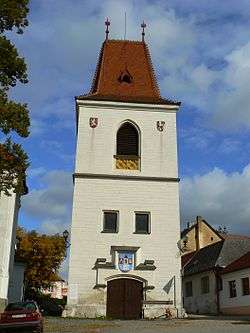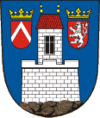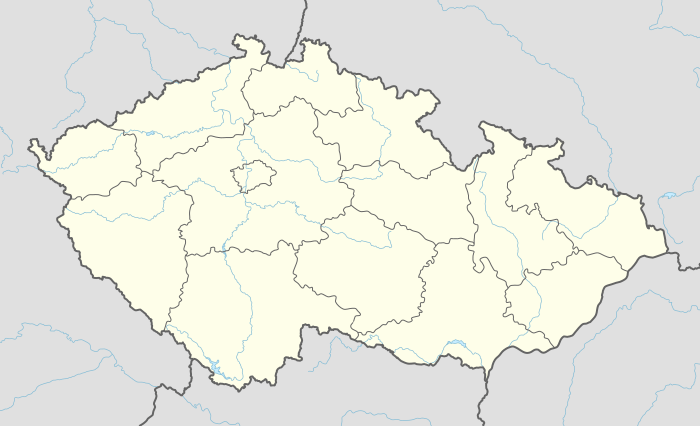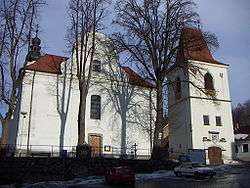Mladá Vožice
Mladá Vožice (German: Jung Woschitz) is a town in the South Bohemian Region of the Czech Republic about 17 km north-east of Tábor.
Mladá Vožice | |
|---|---|
Town | |
 Belfry at the main square | |
 Flag  Coat of arms | |
 Mladá Vožice Location in the Czech Republic | |
| Coordinates: 49°31′59″N 14°48′31″E | |
| Country | Czech Republic |
| Region | South Bohemian |
| District | Tábor |
| First mentioned | 1318 |
| Government | |
| • Mayor | Jaroslav Větrovský |
| Area | |
| • Total | 31.58 km2 (12.19 sq mi) |
| Elevation | 453 m (1,486 ft) |
| Population (2007-12-31) | |
| • Total | 2,728 |
| • Density | 86/km2 (220/sq mi) |
| Time zone | UTC+1 (CET) |
| • Summer (DST) | UTC+2 (CEST) |
| Postal code | 391 43 |
| Website | www.vozice.cz |
History
The town originated from a settlement around a royal castle built on a hill and is known to have two churches as early as Charles IV's period. According to local resources, the castle was erected by Prince Spytihněv's order to house silver from the nearby mines. One of the earliest owners of the town might have been Stanimír z Vožice (Ztanimirum de Bazychce), as known from a 1273 written resource. The town then belonged to several dynasties, one of which gave the town its coat of arms: a tower set on fortification walls with two coats of arms on the sides.
Vožice goods were probably owned by the royal chamber but were frequently pawned or lent to feudal lords for services to the king. One of the first ones was Vilém of Vožice who possessed the estate until 1318. From 1318 to 1425 Vožice was owned by the lords of Landštejn, Janovice, Orlík, Prague and Ronov houses.
In March 1420, after the Battle of Sudoměř, Vožice was occupied by about 2000 horse riders led by Mikeš Divůček of Jemniště, the master of the Kutná Hora mint. On Great Friday morning, 1420, Jan Žižka attacked the town and set it on fire. Many lords were captured or killed and just those who had escaped to the castle got away with their lives. Žižka also seized a lot of horses for his army.
In September 1425, commander Jan Hvězda of Vícemilice aka Bzdinka conquered the castle after five weeks' besiegement. He had the castle destroyed and the town was attached to Vlašim. Mladá Vožice was then owned by many feudal houses, of which Přehořovští of Kvasejovice had a chapel built on top of a hill from the castle ruins in 1646. In 1678 the estate changed owners for the Küenburgs, who adjoined other smaller possessions in the area and established it a hereditary estate.
Community life

Long before 1848 and up to the 1860s, German was spoken among the rich while Czech was only spoken by the common people, who just strived to make a decent living. However, the first signs of community life in Mladá Vožice can be observed as early as late 18th and early 19th centuries but the highlight came after the events of 1848, which marked a breakthrough in the Czech national development. After 1860 the town's teachers and clerks, who had arrived after the school enlargement and establishment of a regional office, tax office and financial pension control, enlivened the town. The ideals of the new national life were also brought to Mladá Vožice by students from their schools and cities.
In 1862 the choir Vlastislav was founded by the patriotic teacher Čeňek Sedmík. At that time a Reading Club strived in the town but later it ceased to exist. Obviously, the national and cultural initiatives came mainly from the immigrant intelligence. For example, the local theatre club established in 1865 was run by educated people including immigrants.
In 1875, the Voluntary Fire Brigade was established. It has expanded since, built a large fire brigade garage in 1945 and at present runs four large fire engines. One year later, the Vožice Academics Club was founded, focusing especially on re-establishing the library after the Reading Club and performing plays.
The magazine Vožičan (Vožice citizen) was issued in 1884 and the young generation published the hand-written magazine Potěr (Spawn). 1885 was marked by the founding of the gymnastics organization Sokol. Josef Joachimsthal, the steward of the Küenburg estate, tried hard to bring railroad to the town from Tábor. Although negotiations were held until the period of the Czechoslovak Republic, they failed and postal bus transport was established instead in 1921, which was taken over by the Czechoslovak State Railways in 1945 and by ČSAD company (the Czechoslovak Automobile Transport) in 1949.
20th century
There used to be a district court in Mladá Vožice, a forestry administration office, a tax office, a gendarme office, a financial pension control, a chemist, two physicians, two veterinarians and a gelder, a notary, two lawyers, two taxis, two hotels, six pubs with three skittles, and three cartmen. There also was an almshouse, a poor hospital, an orphanage, a post office and the cinema Legie (Legion) of the Czech Legionary club. There were four small savings banks and representatives of 4 insurance companies. Mladá Vožice held annual markets, monthly markets and cattle markets, and Thursday piglet markets.
The citizens of Mladá Vožice and surroundings were employed mainly on the count farm, at the sawmill, brickyard, brewery and fish hatchery, they worked on other farms in the area, local distilleries but also in the Vožice quarry, slaughterhouse, agricultural cooperative and granary, mills, state stud farm or were employed in the forest administration.
After 1918 there were also two car repair services, a hosiery mill, laundry and pressing shop as well as a steam power plant, which was later taken over by the company Jihočeské elektrárny (South Bohemian power plants] in Mydlovary near České Budějovice. By 1945 there were 74 various craftsmen and 37 various shops in the town. There was also a small furniture factory and two building companies.
Mladá Vožice citizens made a living by cutting wood for households, bringing water from the fountains, and picking fruit. In the 19th and early 20th centuries they went to work to the gold mine Roudný. Apart from the above mentioned jobs they found seasonal and round-the-year ones all over the republic and before around Austria–Hungary.
The town and neighbourhood of Mladá Vožice was a purely agricultural area until 1945, and the change towards industrialization only began after the liberation. Until 1947 Mladá Vožice had been a court district in the political district of Tábor which occupied an area of 268 km2 and had 17422 inhabitants in 141 villages and remote settlements, associated in 39 political municipalities. It had two towns, Mladá Vožice and Miličín, and one township Kamberk (formerly Zlaté Hory, before that Kamberk). It ranked among the purest Czech regions by nationality.
Since 1949, after the change in the political and state system, Mladá Vožice was included in the newly established district of Votice in Prague region. After the land reorganization of 1960 Mladá Vožice fell under the district of Tábor in South Bohemian Region. In 1975-1980 small villages and hamlets were unified with the town of Mladá Vožice under one national committee (i.e. town council as used between 1945-1990) but after 1989 some of the villages recovered their independence.
Sights

- The St. Martin church is situated on a reinforced terrace above the main Žižka Square. All the church bells were seized in 1942 except for the passing bell; the bell called Jan was returned and blessed as late as 1952[1] and three new bells, Maria, Václav and Martin sounding Gloria in concord, were bought thanks to fund-raising in 1986.
- A chateau was built in the same square between 1570–1603. It owes its present Baroque look to the Küenburgs, who owned it for 250 years. In 1946 the chateau was confiscated and its interiors were used by the Koh-i-Noor factory.[1] At present the building is closed to the public and its condition is poor, owing mainly to unsuccessful restitutions.
- The Assumption of the Virgin Chapel is situated on top of a hill above the town where the royal castle used to stand. It was built by Krištof Karel Přehořovský z Kvasejovic,[1] the owner of the Vožice estate, in 1646.
- The ruin of the castle Šelmberk can be found about 2 km north-east of the town. Unfortunately, just the round keep has been preserved to the present day. It is freely accessible except for the tower, which was made into a museum and observation tower and can be visited in the opening hours.
Gallery
 Belfry from the school
Belfry from the school St Wenceslaus statue in Žižka Sq
St Wenceslaus statue in Žižka Sq
 St Wenceslaus statue in Žižka Sq, opposite house 193 which used to be the seat of the court or health services
St Wenceslaus statue in Žižka Sq, opposite house 193 which used to be the seat of the court or health services
Personalities
- Ota Bubeníček - landscape painter
- Jan Jeník of Bratřice - Austrian military officer and Czech patriot
- Fran Lhotka - composer and musician
- Matthias of Janov - ecclesiastical writer
- August Sedláček - Czech historian, genealogist, sigillographist and heraldist
References
- Markéta Vysloužilová, Mladá Vožice, p. 33-42, Praha (2001)